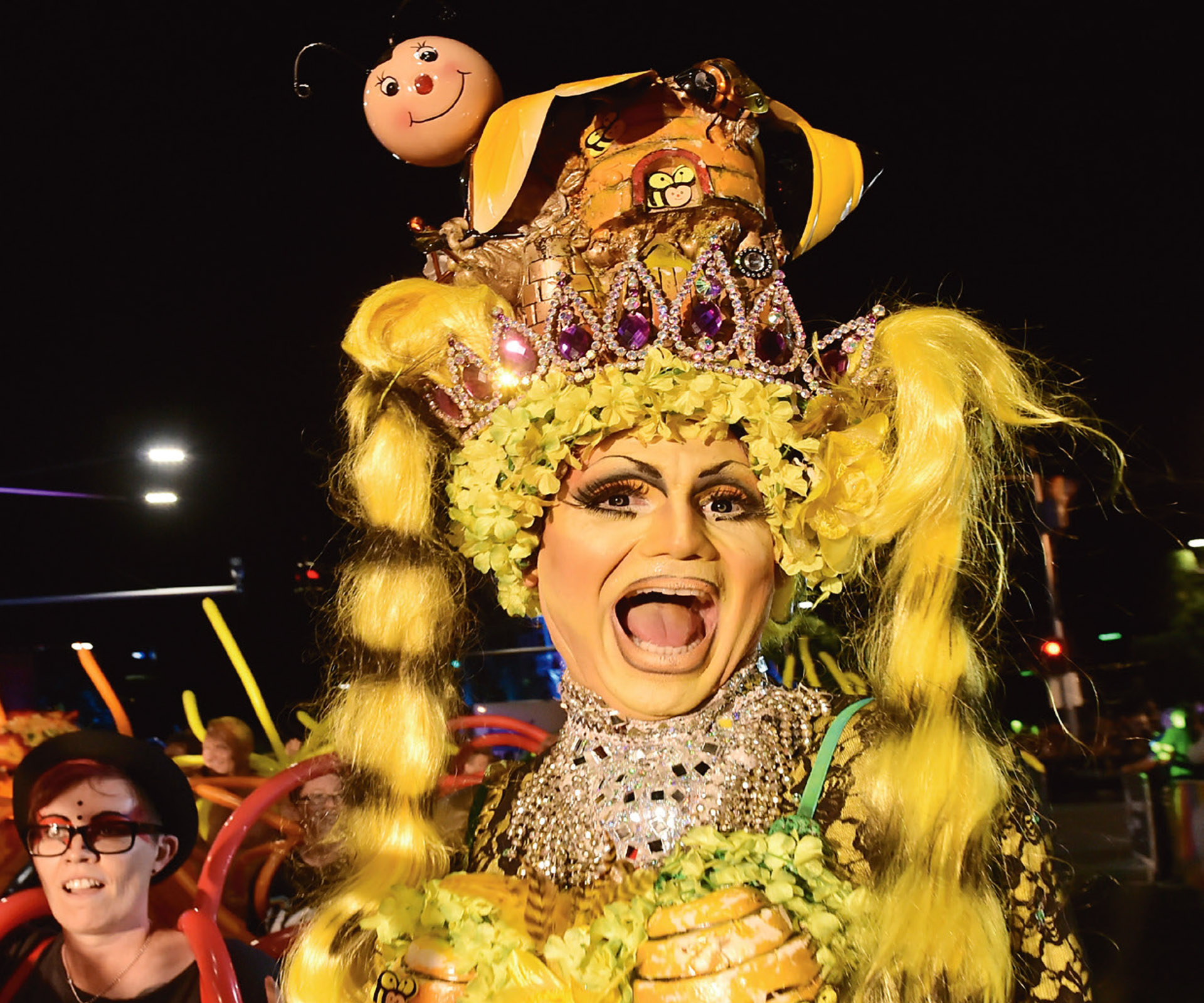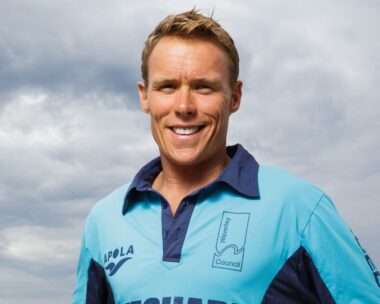Thirsty-seven years after the first parade, Sydney’s gay and lesbian Mardi Gras is not the lightning rod for gay hate it once was. Yet Michael Sheather boards a float to discover there is one more battle to be won.
I now know what Dorothy felt like when she landed in Oz.
Waiting to take my place in this year’s Sydney Gay and Lesbian Mardi Gras, it was hard not to draw parallels between Dorothy skipping down the yellow brick road, surrounded by strange and beautiful creatures, and what I was about to do – dance up Sydney’s Oxford
Street surrounded by thousands of fabulous creatures.
As a heterosexual, family-focused father of three, I never imagined myself taking part in the Mardi Gras parade, the biggest and most famous celebration of gay and lesbian culture in the country.
Yet, here I was, standing in the marshalling area on Liverpool Street, next to Sydney’s Hyde Park, dressed in the official uniform of the GAY380 Qantas float – a day-glow safety vest emblazoned with the Rainbow Roo – sweating my way nervously through stage fright as we waited for “show time”.
Exactly how does a straight, middle-aged man end up in a Mardi Gras parade? The answer is probably testament to how far both the Mardi Gras and the rest of the country has come in its acceptance of homosexuality.
My employer, The Australian Women’s Weekly, wanted a story about what it was like to be in the Mardi Gras. I asked that other Australian icon, Qantas, if they would allow me to join their float. The result was a definitive display of acceptance all round and an invitation to attend rehearsals and learn the Qantas dance routines, where I met 99 men and women – all Qantas employees – keen to strut their stuff.
And after four or five hours of tutelage under the eye of a choreographer, we had it down pat – we were to form the living wings of the GAY380 float, topped and tailed by fibreglass nose and tail pieces, all suitably covered in sparkles.

Danni Minogue strikes a pose with Courtney Act.
As a young man fresh from country NSW, I’d attended a couple of Mardi Gras back in the late 1980s.
They were lively, colourful affairs that even then attracted huge crowds – more than 100,000 in 1987. Yet I wasn’t prepared for the scale of what Mardi Gras has become in the 21st century. This is a production on an epic scale and one that brings in an estimated $30 million to the NSW economy along with tens of thousands of international tourists each year.
Yet Mardi Gras, now in its 37th year, has become decidedly middle-aged. No longer is the parade each year greeted by cries of outrage or demands for censure.
The broadcast of the parade on free-to-air television, once considered risqué, now barely raises an eyebrow.
Mardi Gras becomes less political with each year that passes – as acceptance of homosexuality becomes more of a given with every generation. And the purists – those who marched in the late ’70s and early ’80s at great personal and professional risk – have been given to lamenting the passing of those halcyon days.
There’s arguably no greater evidence of Mardi Gras going mainstream than the huge amount of corporate sponsorship the event attracts. Witness the glitterfication of ANZ ATMs on Oxford St (or GAYTMs as they are renamed for the festival).
ANZ, Telstra and Qantas are all sponsors, having recognised how lucrative is the pursuit of the so-called pink dollar.
“The debut of our Gay380 at the Mardi Gras was a fantastic opportunity to celebrate the diversity of our employees,” says Qantas marketing chief Olivia Wirth.
“We’re absolutely thrilled with the reaction and we’re already planning something bolder and brighter for next year.”

Initially, the parade was a protest march organised by the gay community to highlight harassment by police. These days, it is clear that many of the police on duty in Oxford Street enjoy themselves almost as much as the crowd. The NSW Police float at this year’s parade had the biggest contingent of parade participants since they joined proceedings in 1996.
Indeed, it seemed almost as though the wheel had turned full circle. As we were preparing in the marshalling area on Liverpool Street, the tail wing of our GAY380 float attracted an unprecedented amount of police interest. “That’s just fantastic, I love it,” said one officer looking up at the white kangaroo emblazoned on a rainbow background. “I have to have my photo taken with it.” He jumped up on the trailer with two men covered in gold sparkles and posed for dozens of snaps, something those old-school homophobic cops from the ’80s would never have done.
Across the street, two female officers were posing with a leather-clad vixen from Dykes on Bikes on a massive three-wheeled motorcycle with an explosively rumbling exhaust that shook the ground but somehow didn’t drown out the music.
At this year’s parade, police reported not a single act of violence directed towards the gay community. A far cry from the days when safe houses, marked by pink triangles, were established by members of the community to help prevent the gay bashings which were then commonplace.
Yet even with all this progress, gay and lesbian activists say there remains one hurdle to equality, one reason why it’s essential the Mardi Gras maintains a little bit of rage – marriage equality.
“At the Mardi Gras this year, we saw the armed forces and a whole range of corporate and community groups come out in support of equality,” says NSW politician Alex Greenwich, who attended the parade.
“In 2015, a majority of Australians believe that you should be able to love and marry whoever you wish to.”
Of course, not everyone feels the spirit of acceptance. Fred Nile, the NSW politician who has opposed the parade and its values since its inception in 1978, says that it is, in essence, immoral and tantamount to indecent exposure.
Yet that wasn’t front of mind for the 10,000 people who participated in the parade this year. Slowly, the floats next to us began their journeys up Oxford Street until, finally, the Qantas float was the last on the street.
Because Qantas was a major sponsor, we were also expected to be a highlight.
We shuffled into our positions – a Qantas IT consultant named Darryl to one side of me and an executive named Scott to the front – with Qantas flight paddles in hand. Most were dressed just in the vests and a pair of skimpy pants. Older people – like me – took a more modest approach. Standing next to svelte, semi-naked, gym-honed 30-year-olds when you’re a podgy bloke in his 50s can make you surprisingly self-conscious.

To a disco, up-tempo version of I Still Call Australia Home, we began our well-practised routine – paddles up, paddles crossed, paddles around the world.
Then we spread our arms to imitate a plane banking first right, then left and dance like crazy.
At the rear of the Qantas GAY380 nose cone, Australian drag queen Courtney Act strikes a pose in a stunning sequinned dress flown all the way from Los Angeles especially for the event.
She waves and welcomes the crowd to a happy Mardi Gras.
As we make our way onto Oxford Street, the atmosphere is suddenly electric. There are thousands upon thousands of people lined up 10-deep and as we wave our paddles and begin our flight – complete with a series of Mexican waves that make it look like the wings are actually flapping – the cheering becomes almost deafening.
Finally, as we turn into Taylor Square, we bank to the right, squeezing from a formation spread over two lanes of roadway into one and Courtney stands aside as we are showered with millions of red sparkles from a pair of cannons mounted on the nose cone trailer.
We’ve been told that it’s important we look fabulous at this point because not only is this to be the climax of the parade, but also because Qantas Chief Executive Alan Joyce is watching from a balcony above us.
It’s hot, too. And we’re still dancing. The parade takes about an hour and, by the end, we are all drenched and running out of puff. Yet it was a lot of fun, something I’ll always remember.
As we come to the end of the route, we peel off and say our goodbyes. Some are heading back to the city, some to dinner, some to the after-party.
I look down and notice that my shoes are covered in red glitter, not unlike those shoes that Dorothy ended up with in The Wizard Of Oz. I click my heels, but nothing happens. Like most of the 200,000 who watched the parade, I still have to get public transport home.
A version of this story originally appeared in The Australian Women’s Weekly Magazine April 2015.
A video you might also like: Watch your fave celebs read Kanye West’s best tweets and LOL.




